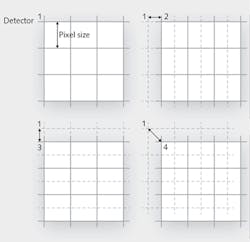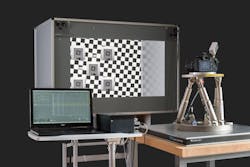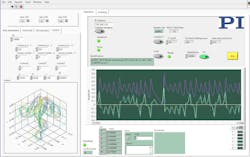Imaging: Piezo and hexapod motion systems improve image stability and resolution
The quest for higher-resolution imaging pushes optical designers and manufacturers of motion-control equipment to overcome physical limitations. While megapixel inflation still seems to be the main focus of the consumer camera market, scientific applications are different. There is a tradeoff between sensitivity and resolution, and disturbances such as vibrations or fluctuations in the atmosphere or in fluids are detrimental to image quality—especially in low-light conditions.
Image-dithering methods and active image stabilization based on precision mechanisms and motion control are modern means to improve digital image quality. Precision motion control is also gaining importance in test equipment, where prerecorded vibration sequences are "played-back" as six-dimensional motion trajectories on hexapod platforms simulating different environments, including vehicle vibration and camera shake induced by the human muscular system.
Image quality through motion control
If electrical noise was a non-issue in digital imaging sensors such as complementary metal-oxide semiconductor (CMOS) or charge-coupled device (CCD) chips, image quality could be improved significantly with minimum cost. However, in the real world, low photon count leads to an unfavorable signal-to-noise ratio, creating difficulties for imaging applications from astronomy to microscopy—highly sensitive detectors often lack the desired resolution and the highest resolution detectors lack sensitivity. The result is either a shortage of detail or excessive image blur with long exposure times.
The resolution of digital image-recording methods is mostly determined by the number of pixels on a sensor and improvements either require increasing the area (sensor size) or decreasing pixel size. Unfortunately, the first case requires different imaging optics, and in the second case, the light sensitivity decreases with the pixel size, leading to reduced signal.
However, there are methods based on mechanical motion-control systems that can readily increase imaging resolution in a variety of applications, including fluorescence microscopy, white-light interferometry, optical coherence tomography (OCT), or in surveillance cameras and cameras for aerial photography (see Fig. 1).
Using both motion-control hardware and software algorithms, image resolution can be significantly improved with relatively little effort. Furthermore, these mechanical methods can also simulate challenging environments with jitter or vibration to develop image stabilization techniques that improve imaging resolution and quality.
Piezo actuators: speed and resolution
A special form of electro-ceramics, piezoelectric (piezo for short) actuators, are widely used for applications where precision, speed, and force are required in a small package. Based on the inverse piezoelectric effect, piezo-ceramic discs expand when an electric field is applied, causing the actuator to move. To make these piezo systems more accessible for OEM designers, manufacturers package the actuators inside an arrangement of flexures, providing precision guidance and amplified motion along with a simple mounting interface.
Flexures are usually made of aluminum, steel, or titanium. With flexure motion-amplifiers, travel ranges up to 2 mm can typically be achieved with resolutions down to the nanometer range. High dynamics—the ability to accelerate and stop quickly—because of the high stiffness of the active ceramic elements can result in scanning frequencies of up to several kilohertz.
Piezo actuators are free of wear, do not require lubrication, and are non-magnetic and vacuum-compatible. With the absence of friction and wear, they can provide billions of cycles of maintenance-free service. Physik Instrumente (PI; Karlsruhe, Germany) ceramic-encapsulated PICMA actuators were life-tested by NASA/JPL and survived 100 billion cycles without failures—they have been running on the Mars Rover's Science Lab for almost four years.
The additional motion provided by flexure-amplified piezo actuators does, however, come at a price. With increasing amplification ratio, both stiffness and responsiveness are reduced. Nevertheless, well-designed piezo flexure actuators can still provide sub-millisecond step-and-settle times—significantly faster than any other conventional actuator. And when integrated into flexure arrangements, piezo actuators can provide multi-axis motion. For example, they can be integrated in high-end custom cameras for image stabilization or resolution enhancement based on the pixel sub-stepping principle.
Pixel sub-stepping
When pixel sub-stepping is used within an imaging system, the recording area of the sensor is moved on a defined path with a defined frequency in sub-pixel increments. This dithering, where the travel is less than the size of a pixel, causes the pixel to be exposed several times on the recording area, producing a virtual "pixel multiplier" that can significantly improve the resolution (see Fig. 2). With the help of data processing, the various images produced in this way are subsequently superimposed to form the final, high-resolution image—a process also known as super-resolution imaging.Since this method is based on motion, a mechanical drive is required that meets all the performance criteria for mechanical precision and lifetime. The drives differ with the application, but they all have crucial features in common: the motion of the sensor chips must be reproducible in two dimensions with sufficient linearity, and the travel is on the order of the pixel size—a few tens of micrometers or less.
The dynamics required range from a few hertz for still images up to the kilohertz range for video recordings. The basic requirement for high-resolution biometric CCD/CMOS scanners used to identify persons by their fingerprints is, for example, a scanning frequency between 1 and 5 Hz with a response time <1 ms. The travel for the drives is between 5 and 15 μm, with precision >0.5 μm in the smallest possible mounting space.Astronomy/microscopy applications
Fast piezo-driven scanning devices can also improve imaging in astronomy and microscopy applications. For astronomy, active mirrors (tip/tilt motion) and adaptive mirrors (multiple actuators deforming the mirror surface) have shown improvements in spatial resolution by more than one order of magnitude.
Modern telescopes collect light with huge primary mirrors—the larger the mirror, the more photons are collected. The primary mirror of the Subaru Telescope on Mauna Kea, HI spans 8.3 m and sends light onto several smaller mirrors until it finally hits the imaging detector.
Earthbound telescopes are impacted by atmospheric turbulence that distorts the wavefront (what humans perceive as the twinkling of the stars) and wind buffeting that induces vibration in the telescope structure. To counteract these limitations, fast, highly precise mechanisms are integrated in the secondary and tertiary mirrors. Using these smaller and lighter downstream mirrors, motion-control components with sub-micron linear precision, sub-microradian angular precision, and bandwidth in the hundreds of hertz can limit external disturbances.
Piezo-ceramics are often used in these active and adaptive systems because they provide high forces, sub-millisecond responsiveness, and atomic-scale resolution. The goal of an adaptive optics project via a cooperation between the Fraunhofer Institute for Applied Optics and Precision Engineering IOF (Jena, Germany) and PI in Karlsruhe, for example, is to develop a new generation of extremely accurate adaptive optics (XAO) based on 11,000 PICMA multilayer piezo actuators for the European Extremely Large Telescope (E-ELT) that will be built in the Chilean Atacama Desert in 2024.
To break the diffraction limit in light microscopy, several scanning techniques are available using piezoelectric drives with nanometer resolution. In super-resolution microscopy, faster scanning means faster image acquisition and lower risk of photobleaching effects.
The first optical microscopes to significantly break the diffraction limit about 30 years ago were scanning near-field optical microscopes (SNOMs) that rely on a small probe tip with subwavelength aperture scanned across the surface, while maintaining a precise distance between the tip and the sample in the nanometer realm. For SNOMs to work, nano-precision mechanisms are needed for both the scanning apparatus and to control the tip-to-sample distance.
Another technique called stimulated emission depletion (STED) microscopy was first explored by Stefan Hell in 1994 when looking for ways to measure transparent 3D photoresistive microstructures for the semiconductor industry. In STED microscopy, an annular laser beam excites fluorescence only in a nanometric volume at a time. By scanning the beam with nanometer-resolution mechanisms and correlating the exact position with the optical data collected, a super-resolution image is possible.
Many other super-resolution techniques, including light-sheet microscopy and 4PI microscopy, require some form of nanometer-precise mechanism to scan probes, samples, and optics, or to control constructive and destructive interference. Multi-axis piezo scanners such as the PInano stage, for example, can create high-resolution 3D bio-images by quickly scanning a bio-sample in multiple planes separated by fractions of a micron. The data of each scanned plane is combined by software, creating a multi-dimensional, highly detailed image.
Motion simulation
The aforementioned mechanisms for image resolution enhancement rely on fast controllers and algorithms to make the most of their capabilities. To test the overall effectiveness and improve the systems, motion simulation is crucial. Here, precision multi-axis mechanisms with controllers and software that allow highly repeatable execution of pre-recorded or synthesized patterned motion are fundamental.
Today, motion simulation is used for a great variety of applications, including vibration testing of vehicles or airplanes and response testing of accelerometers, gyroscopes, and image sensors, such as those used in high-end cameras and smartphones (see Fig. 3). Repeatable multi-axis motion simulation can help tweak advanced algorithms in image stabilization systems and verify the performance of optomechanical or electronic stabilizers.The Camera and Imaging Products Association (CIPA; Tokyo, Japan), an international alliance of camera manufacturers, establishes standards for the test and evaluation of image stabilization systems, with DC-011-2015 being its latest standard for motion simulation test conditions.
For high-quality test results, motion simulators need to provide highly repeatable motion with precisely the same dynamics (vibration direction, acceleration, and magnitude) as the original motion they are trying to simulate. This involves running high-precision trajectories with the corresponding dynamics in multiple axes.
Stewart platforms, commonly called hexapods, have become the standard for multi-axis simulation tasks when high precision is required. A hexapod is a parallel kinematics system consisting of six actuators arranged in parallel between a top and bottom platform. Hexapods have many advantages over serial kinematics stages, such as lower inertia, improved dynamics, smaller package size, and higher stiffness. In addition, hexapods are more flexible than conventional six-axis positioners, allowing a programmable, randomized center of rotation.
Advanced hexapod controllers can also cast the hexapod coordinate system's origin and orientation anywhere in space rather than being fixed by the mechanical configuration of the system.
Hexapod drive types and applications
Several drive types are available for different load and frequency ranges. Hexapods with electromagnetic brushless servo motors and screw-type actuators can provide good balance of high load capacity, stiffness, and low power consumption. Load capacities of 100 lbs and more are feasible and, with the appropriate mechanical design of the drivetrain and sensor technology, can achieve accelerations to 2 g. They also provide an inherently stiff-drive mechanical design that can hold a position on power-off.
Even higher performance is feasible with voice coil drives (based on the principle of a loudspeaker driver; see https://youtu.be/BQJg7I-4620) such as used in the H-860KMAG flexure-guided, direct-drive hexapod. Here, accelerations to 4 g with velocities of several hundred millimeters per second are possible. The frictionless flexure guides and joints enable zero-backlash motion without the vibrational noise caused by traditional mechanical bearings—that is, undesired frequency components coupled in from the mechanical system cannot influence the measurement.
In addition to drone-camera stabilization testing with an H-840 hexapod (see https://youtu.be/RPJpNSTX7wA), a PI H-900KSCO hexapod was designed for industrial automation and stabilization of motion on moving vehicles and vessels, handling loads up to 130 lbs while providing motion ranges to 200 mm (in x, y, and z) and 66° (pitch, yaw, and roll) with velocities to 80 mm/s and 30°/s, respectively. And finally, using carbon fiber struts, the H-860 high-dynamics voice coil hexapod has frictionless flexures throughout its drivetrain to eliminate minute vibrations caused by rolling elements (see https://youtu.be/SlKMu29zbM4).
Hexapod waveform generation
The hexapod controller's built-in waveform generation function is capable of internal generation of millions of target positions to run complex multi-axis motion profiles with sub-micrometer precision at speeds of up to thousands of points per second, addressing aliasing and motion-generation artifacts—the closer the points, the smother the motion and the lower the unwanted vibration. Rapid controller communication occurs through high-speed interfaces such as TCP/IP Ethernet, SPI, EtherCAT, and real-time TTL for synchronization with external events.
For rapid application development of complex motion waveforms, software tools operating across Windows, OS X, and Linux operating systems are critical. Dynamic libraries make for quick and productive programming in any language, while a simple, mnemonic ASCII command set makes for quick work in terminals or any scripting environment.
An extensive, well-wrung-out, cross-platform-compatible LabVIEW library facilitates development of detailed and intuitive user interfaces on that platform as well (see Fig. 4). An example application offers multi-axis arbitrary waveform generation, including independently selectable sine, square, triangle, sawtooth, and swept-sine actuation, or the ability to import custom or proprietary position-vs.-time tables in spreadsheet format.With the variety of motion-control parameters such as physical size, load capacity, speed, precision, travel range, and cost, it is obvious that one piezo mechanism or multi-axis motion system cannot fit all applications. However, the large amount of standard systems offered facilitates proof of concept—and custom solutions are available for OEM design engineers.
About the Author
Stefan Vorndran
Stefan Vorndran is VP of marketing at PI (Physik Instrumente; Auburn, MA).
Scott Jordan
Head of Photonics, PI (Physik Instrumente)
Scott Jordan is Head of Photonics at PI (Physik Instrumente; Auburn, MA).



